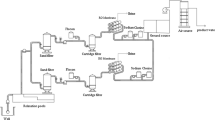Abstract
Reverse osmosis desalination membranes can be utilized to purify seawater creating clean water. To meet purity requirements multiple membrane modules are typically required and the configuration should be chosen to minimize energy consumption and costs. Here a numerical model is proposed based on a tanks-in-series formulation of model equations. This model was validated against reverse osmosis system analysis (ROSA®) simulation software and used to investigate the performance of a number of different configurations. Systematic evaluation was made on how the performance of membrane systems is influenced by the arrangement of multiple vessels for the multi-module design of membranes systems.
Similar content being viewed by others
Abbreviations
- C:
-
concentration [kg m−3]
- dh :
-
hydraulic diameter [m]
- D:
-
diffusivity [m2 s−1]
- i:
-
index or tank number in tanks-in-series model
- JW :
-
water flux [m s−1]
- J S :
-
salt flux [kg m−2 s−1]
- JB :
-
boron flux [kg m−2 s−1]
- k:
-
mass transfer coefficient [m s−1]
- k dc C td A′ n:
-
coefficients used in Eqs. (13) and (14) [dimensionless]
- l :
-
length of membrane mesh spacer [m]
- L:
-
length of membrane unit [m]
- M:
-
empirical parameter defined by Eq. (9)
- N:
-
number of tanks used in the tanks-in-series model
- Q:
-
volume flow rate [m3h−1]
- P:
-
pressure [Pa]
- PW :
-
waterpermeability[m s−1Pa−1]
- r:
-
relation coefficient between salt and boron mass transfer [dimensionless]
- Re:
-
Reynolds number [dimensionless]
- Sh:
-
Sherwood number [dimensionless]
- u:
-
linear velocity [m s−1]
- T:
-
temperature [C]
- Pm :
-
water permeability [m s−1Pa−1]
- Ps :
-
salt permeability [m s−1]
- PBborate :
-
borate ion permeability [s m−1]
- PBboric :
-
boric acid permeability [s m−1]
- Rm :
-
membrane resistance to water [Pa s m−1]
- Rs :
-
membrane resistance to salt [s m−1]
- π :
-
osmotic pressure [Pa]
- ρ :
-
density [kg m−3]
- f:
-
feed
- r:
-
retentate
- p:
-
permeate
- b:
-
bulk (average value inside a tank)
- B:
-
boron
- m:
-
value at the membrane wall
- W:
-
water
References
A. A. Alsarayeh, M. A. Al-Obaidi, R. Patel and I. M. Mujtaba, Processes, 8, 573 (2020).
World Health Organization, Guidelines for drinking-water quality: Fourth edition incorporating the first addendum, Geneva, Switzerland (2017).
A. Abbas, Chem. Eng. Process., 44, 999 (2005).
M. A. Al-Obaidi, J.-P. Li, S. Alsadaie, C. Kara-Zaitri and I. M. Mujtaba, Chem. Eng. J., 350, 824 (2018).
V. Geraldes, N. E. Pereira and M. N. de Pinho, Ind. Eng. Chem. Res., 44, 1897 (2005).
S. Senthilmurugan, A. Ahluwalia and S. K. Gupta, Desalination, 173, 269 (2005).
S. Avlonitis, W. T. Hanbury and M. Ben Boudinar, Desalination, 89, 227 (1993).
S. Sundaramoorthy, G. Srinivasan and D. V. R. Murthy, Desalination, 280, 403 (2011).
P. P. Mane, P. K. Park, H. Hyung, J. C. Brown and J. H. Kim, J. Membr. Sci., 338, 119 (2009).
H. Hyung and J. H. Kim, J. Membr. Sci., 286, 269 (2006).
Y. Du, Y. Liu, S. Zhang and Y. Xu, Ind. Eng. Chem. Res., 55, 12860 (2016).
M. Binns, Analytical models for seawater and boron removal through reverse osmosis, Sustainability, 13, 8999 (2021).
O. Levenspiel, Chemical reaction engineering, 3rd ed., Wiley and sons, New Jersey (1999).
T. Katoh, M. Tokumura, H. Yoshikawa and Y. Kawase, Sep. Purif. Technol., 76, 362 (2011).
M. Binns, S. Lee, Y. K. Yeo, J. H. Lee, J. H. Moon, J. G. Yeo and J. K. Kim, J. Membr. Sci., 497, 458 (2016).
S. Lee, M. Binns, J. H. Lee, J. H. Moon, J. G. Yeo, Y. K. Yeo, Y. M. Lee and J. K. Kim, J. Membr. Sci., 541, 224 (2017).
C. Lee, Y. Kang, D. Kim and I. Kim, Membranes, 11, 240 (2021).
A. Ruiz-Garcia, F. A. Leon and A. Ramos-Martin, Desalination, 449, 131 (2019).
M. Taniguchi, M. Kurihara and S. Kimura, J. Membr. Sci., 183, 259 (2001).
ROSA: reverse osmosis system analysis software, version 7, Dow Chemicals.
Acknowledgement
This work was supported by the National Research Foundation of Korea (NRF) (No 2019R1A2C2002263) funded by the Korea government (MSIT).
Author information
Authors and Affiliations
Corresponding authors
Rights and permissions
About this article
Cite this article
Kim, M., Binns, M. & Kim, JK. Process modeling and design of reverse osmosis membrane system for seawater desalination. Korean J. Chem. Eng. 39, 1375–1383 (2022). https://doi.org/10.1007/s11814-022-1086-3
Received:
Revised:
Accepted:
Published:
Issue Date:
DOI: https://doi.org/10.1007/s11814-022-1086-3




